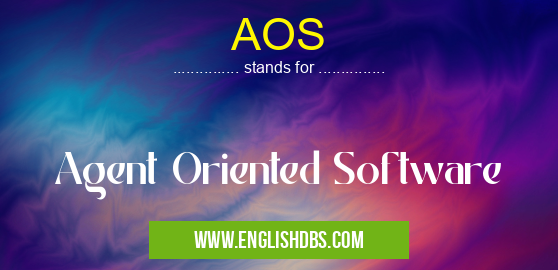What does AOS mean in SOFTWARE
AOS (Agent Oriented Software) is a software engineering paradigm that emphasizes the use of autonomous, self-sufficient agents to construct software systems. These agents are often modeled as objects, but they can be any type of software entity that can act independently.

AOS meaning in Software in Computing
AOS mostly used in an acronym Software in Category Computing that means Agent Oriented Software
Shorthand: AOS,
Full Form: Agent Oriented Software
For more information of "Agent Oriented Software", see the section below.
AOS is a relatively new paradigm, but it has been gaining popularity in recent years as the complexity of software systems has increased. AOS can help to reduce the complexity of these systems by allowing the software to be decomposed into a set of smaller, more manageable agents.
Advantages of AOS
- Modularity - AOS systems are modular, which makes them easy to maintain and update.
- Scalability - AOS systems can be scaled to accommodate a large number of users and transactions.
- Reusability - AOS agents can be reused in multiple applications.
- Concurrency - AOS systems can be designed to run concurrently, which improves performance.
- Autonomy - AOS agents are autonomous, which means that they can make decisions and take actions without human intervention.
Disadvantages of AOS
- Complexity - AOS systems can be complex to design and implement.
- Overhead - AOS agents can overhead, which can impact performance.
- Security - AOS systems can be vulnerable to security attacks.
Applications of AOS
AOS has been used to develop a variety of applications, including:
- Multi-agent systems
- Robotics
- Artificial intelligence
- E-commerce
- Healthcare
Essential Questions and Answers on Agent Oriented Software in "COMPUTING»SOFTWARE"
What is Agent Oriented Software (AOS)?
Agent Oriented Software (AOS) is a software development paradigm that utilizes autonomous, proactive, and goal-directed software agents to solve complex problems. These agents interact with each other and their environment to achieve desired outcomes.
What are the benefits of using AOS?
AOS offers several benefits, including:
- Modularity: Agents are independent and self-contained, making them easy to develop, maintain, and reuse.
- Flexibility: Agents can adapt to changing environments and respond to unexpected events in real-time.
- Concurrency: Agents can operate concurrently, enabling efficient handling of multiple tasks.
- Intelligence: Agents can process information, make decisions, and learn from their experiences.
What are the challenges of developing AOS?
AOS faces certain challenges, such as:
- Complexity: Coordinating multiple agents in a complex system can be challenging.
- Communication: Ensuring effective communication between agents is crucial for successful collaboration.
- Security: Securing agents and their interactions is essential to prevent unauthorized access or malicious behavior.
What are the applications of AOS?
AOS has diverse applications across various domains, including:
- Autonomous Systems: Developing self-driving vehicles, drones, and other autonomous systems.
- Distributed Computing: Coordinating tasks and resources in distributed systems.
- Simulation and Modeling: Creating realistic simulations and models of complex systems.
- Healthcare: Optimizing patient care and improving healthcare delivery.
- Finance: Automating financial transactions and analyzing market data.
What are the future prospects of AOS?
AOS is an active research area with promising future prospects. Advancements in artificial intelligence (AI), machine learning, and cloud computing are expected to drive the growth and adoption of AOS in various industries.
Final Words: AOS is a powerful software engineering paradigm that can be used to develop a wide variety of applications. However, it is important to be aware of the advantages and disadvantages of AOS before using it in a project.
AOS also stands for: |
|
| All stands for AOS |
